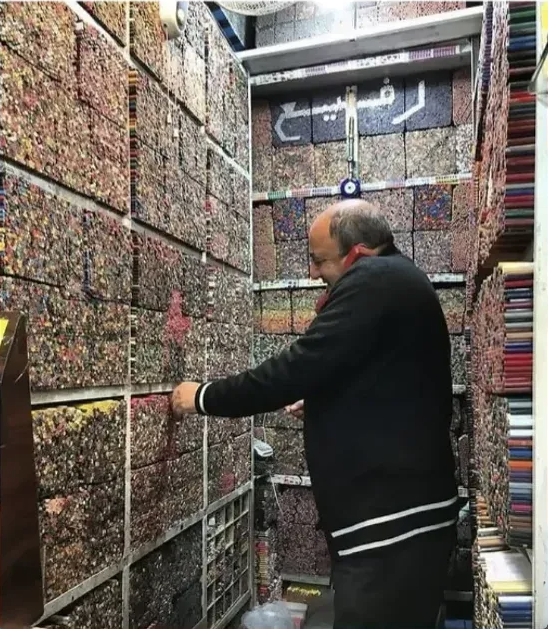
Hassan has run his colored pencil shop in Tehran for thirty years. Walk in and you’ll see why it’s been called an artist’s dream—every wall is covered floor to ceiling with thousands of pencils in rainbow cascades. Burnt sienna next to cadmium orange. Cerulean blue beside midnight navy. Every shade imaginable, organized in a system only Hassan fully understands.
When an art student walks in asking for something specific—”burnt sienna with an orange undertone”—Hassan doesn’t consult a computer or search through catalogs. He walks directly to a middle shelf, reaches without looking, and pulls the exact pencil needed.
“This is what you need,” he says, handing it over.
He knows the location and shade of every single pencil—a living catalog of color in a shop that looks like a rainbow exploded and decided to stay.
The photo captures Hassan reaching for one of thousands of pencils, surrounded by walls so densely packed with color they almost vibrate. The shelves stretch high above his head, creating corridors of hue and pigment that would overwhelm anyone who didn’t know them intimately.
But Hassan knows them. After thirty years, these pencils aren’t just inventory—they’re old friends. He’s memorized their positions the way some people memorize faces. He knows which blues lean purple, which reds have pink undertones, which yellows work best for sunlight versus lemons.
Artists come from across Tehran to visit Hassan’s shop because nowhere else can they find this selection, this organization, this expertise. He’s not just selling pencils—he’s curating possibility. Every pencil represents a potential sunset, portrait, landscape. Every shade is a tool for creation in hands that know how to use it.
There’s something beautiful about mastery that looks like magic. Hassan’s ability to locate any pencil among thousands isn’t supernatural—it’s the result of three decades of attention, care, and dedication to a craft most people would consider mundane. Selling pencils. Not painting with them, just selling them.
But Hassan understands something deeper: that enabling artists is its own form of art. That being the person who provides the exact shade someone needs to complete their vision is participation in that creative act. That his shop isn’t just retail—it’s a laboratory of color where artists come to find the tools they need to make something beautiful.
In an age of online shopping and algorithm-driven recommendations, there’s something profoundly human about Hassan’s shop. You can’t get this experience from Amazon. You can’t replicate the feeling of being in a physical space so saturated with color it changes how you see. You can’t replace the expertise of someone who’s spent thirty years learning the subtle differences between shades that look identical to untrained eyes.
Hassan’s shop is a reminder that specialization matters, that expertise accumulated over decades has value beyond efficiency. Any computer database could tell you where a pencil is located. But Hassan can tell you which pencil will work best for your specific need, which alternative might serve even better, which combination of shades will achieve the effect you’re imagining.
He’s not just a shopkeeper. He’s a color consultant, an art enabler, a guardian of possibility.
The art student who asks for burnt sienna with an orange undertone walks out with exactly what they needed, probably still marveling at how Hassan knew instantly which shelf to check, which pencil to pull. They’ll go home and create something—a portrait, a landscape, an abstract piece—and somewhere in that creation will be the exact shade Hassan provided.
He won’t see the finished artwork. Won’t know what they made. But he’ll have played a small, essential role in its creation. That’s what thirty years in a colored pencil shop has taught him: that his work matters not because he creates art, but because he makes art possible for others.
In Tehran, in a shop that looks like an artist’s dream, Hassan walks among thousands of pencils and knows each one by heart. After thirty years, the rainbow has become his native language. And artists keep coming, knowing that somewhere in those cascading walls of color is exactly the shade they need.
And Hassan will find it without looking.